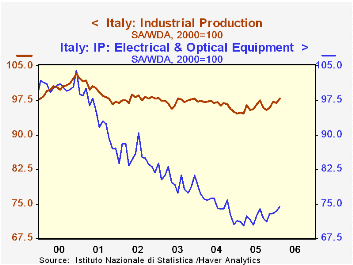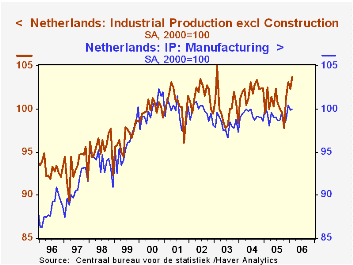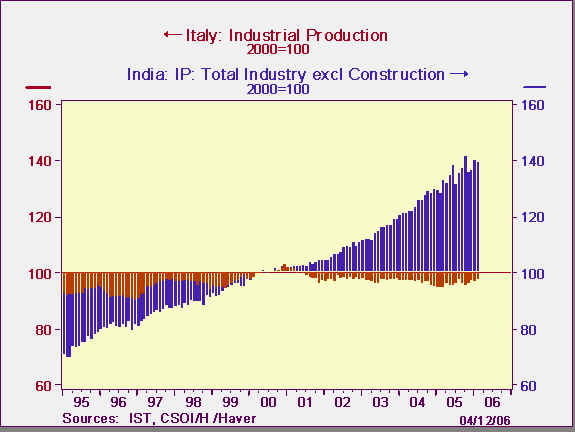 Global| Apr 12 2006
Global| Apr 12 2006Stirrings of Industrial Production Growth in Italy, Netherlands; India Extends Uptrend
Summary
Industrial production reports from Italy and Netherlands give encouraging views of activity in those countries in February, hinting at least at stabilization or potentially an upturn. Industrial activity in India, meanwhile, dipped [...]

Industrial production reports from Italy and Netherlands give encouraging views of activity in those countries in February, hinting at least at stabilization or potentially an upturn. Industrial activity in India, meanwhile, dipped slightly in February after a strong gain in January, basically extending the protracted uptrend in that nation.
Production was up 0.8% in Italy, the third sizable rise in the last four months. The year-on-year gain was a quite respectable 3.3%. A variety of industries contributed: wood products, publishing, metals and metal products and machinery. Leather and footwear and electrical equipment extended flat patterns which have followed long-lasting declines (see the first graph). The seasonally adjusted index in February was 97.8 (2000=100), the highest since December 2003.
In the Netherlands, total production rose a notable 1.4% in the month, but that followed an 0.8% decrease in January. Food production, textiles and electrical equipment have all added to total output. But other industries have been sluggish, so the overall manufacturing sector, while tending higher, gives a less decisive picture. Mining and quarrying activity and utility output have been up sharply the last few months, causing the stronger performance of the total index.
India, in contrast, persists in expansion. A modest decrease in February of 0.14% followed a 2.36% jump the month before. The year-on-year advance is 8.8%. Leading industries include rubber, plastics and petroleum products, nonmetallic minerals, metals, machinery and "other". 
India reports its index on a base year of fiscal 1993=100, that is, April 1993-March 1994. We can quickly convert it to a calendar year 2000 base, facilitating comparison with Italy and the Netherlands. In Haver's software DLXVG3, one of the "Advanced Functions" is "Index": click "fn" or use the keystroke Alt-F; the box that opens includes a choice called "Index", allowing users to insert the year they want as a base. Thus, we can see quickly in the the third graph that while industrial production in Italy is actually below its 2000 amount, that in India has grown some 39.5%. Note that we drew the graph using the "horizontal reference" feature. This is listed in the "Graph" drop-down menu; we set it at 100. Then if we ask for the graph to be a bar-chart (by clicking on the "bars" up in the tool-bar, the software will center the graph's bars above and below our chosen reference line.
| Industrial Production | Feb 2006 | Jan 2006 | Dec 2005 | Feb 2005 | 2005 | 2004 | 2003 |
|---|---|---|---|---|---|---|---|
| Italy (2000=100) | 97.8 | 97.0 | 97.3 | 94.9 | 95.9 | 96.8 | 97.3 |
| Netherlands (2000=100) | 103.7 | 102.3 | 103.1 | 102.5 | 100.7 | 102.1 | 100.1 |
| India (FY93=100) | 224.9 | 225.2 | 220.0 | 206.6 | 216.6 | 200.8 | 185.2 |
| (Cal2000=100) | 139.5 | 139.6 | 136.4 | 128.1 | 134.3 | 124.5 | 114.8 |
Carol Stone, CBE
AuthorMore in Author Profile »Carol Stone, CBE came to Haver Analytics in 2003 following more than 35 years as a financial market economist at major Wall Street financial institutions, most especially Merrill Lynch and Nomura Securities. She had broad experience in analysis and forecasting of flow-of-funds accounts, the federal budget and Federal Reserve operations. At Nomura Securities, among other duties, she developed various indicator forecasting tools and edited a daily global publication produced in London and New York for readers in Tokyo. At Haver Analytics, Carol was a member of the Research Department, aiding database managers with research and documentation efforts, as well as posting commentary on select economic reports. In addition, she conducted Ways-of-the-World, a blog on economic issues for an Episcopal-Church-affiliated website, The Geranium Farm. During her career, Carol served as an officer of the Money Marketeers and the Downtown Economists Club. She had a PhD from NYU's Stern School of Business. She lived in Brooklyn, New York, and had a weekend home on Long Island.





